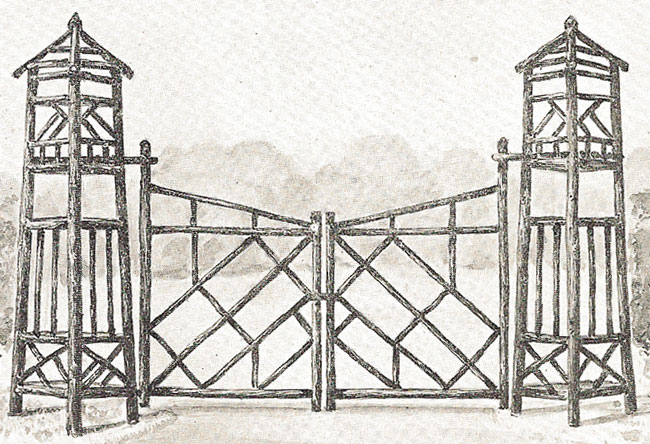Rustic Garden Structures
During the height of garden preparations here in the Northeast, we are thinking about rustic garden structures.
Only once have we had large antique rustic twig garden ornaments for sale. It was a pair of 8’ high twig obelisks that we assumed had lived inside a conservatory, as they were still intact at 80 or more years of age. We took them to a show a few days after finding them, and they sold during set-up to a patron of the show who was given early preview privileges.
We didn’t even have a chance to take pictures of them before they sold, but they were similar to these gate posts made by the Dixie Wood Company, circa 1920:
We agreed to deliver them to the buyer’s home before the show started. Having heard about her legendary gardens, we expected to see the seventy-something year old lady wearing kid gloves, assiduously tending her rose bushes.
Much to our surprise what we saw instead was a legion of garden workers, including a full-time head gardener with a half-dozen minions. The gardens were gorgeous, but the experience helped to put into perspective what it takes to construct and maintain such beautiful private gardens – a good reality check as we design and labor in our own home gardens.
The obelisks fit in exactly where she had envisioned placing them, so it was a pleasure to leave them behind in such a glorious place.
It is not surprising that old twig garden structures do not often appear on the market – either they were permanently installed and too big to relocate, or more likely, have rotted away. Yet decorative rustic garden structures have been ubiquitous for over a century. These two circa 1875-1880 tintypes (jcosmasvintage.tumblr.com) reflect their popularity, as photographers used them as props to add a bit of rustic allure to studio portraits.
A few decades after these images were taken, hickory furniture companies started to manufacture rustic garden structures along with rustic furniture. The 1914 Old Hickory Chair Company catalog advertised a variety of forms including bridges, fences, gazebos and pergolas, as seen in these pages:
Rustic Hickory Furniture Company of LaPorte, Indiana also sold garden structures, such as this covered lawn seat and tea house from their 1926 catalog:
While any outdoor structure made of untreated hickory would not have had enormous longevity, those made of cedar had a better chance of withstanding the elements. During the same time period that hickory garden structures were being manufactured, a variety of companies were making rustic cedar structures, including these fences and arch from Lincraft in New Jersey,
and these “sun houses” and arbor from Cedarcraft in Michigan:
Today it is more common for antique geometric twig work that is similar to the designs of rustic architectural elements to turn up in chairs and benches that have survived because they were not fully exposed to harsh weather. This sassafras bench that we owned a few years ago is a good example.
A very similar bench also made an appealing prop for a tintype portrait 138 years ago (blackmarketantiques.com):
While we expect to continue to find geometric twig furniture like this, it is unlikely that we’ll come across similar antique outdoor structures for sale. But perhaps the designs presented here will inspire you to build your own, should your early summer agenda include ornamenting your home landscape with rustic structures.

























